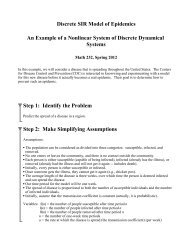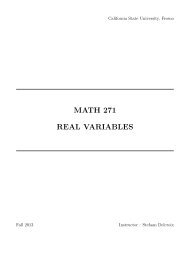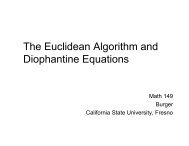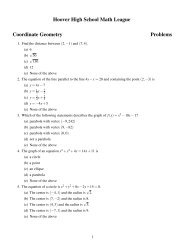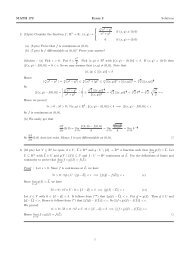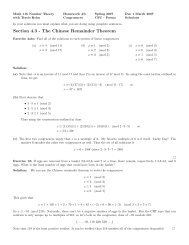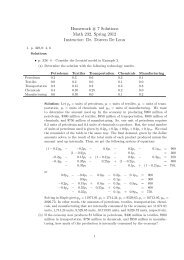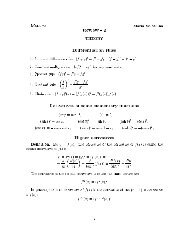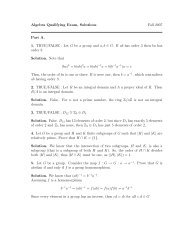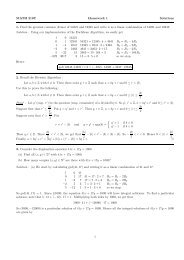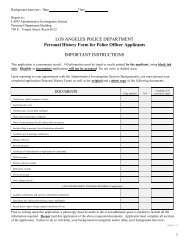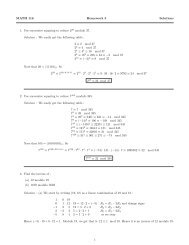Modeling with Proportionality and Geometric Similarity
Modeling with Proportionality and Geometric Similarity
Modeling with Proportionality and Geometric Similarity
You also want an ePaper? Increase the reach of your titles
YUMPU automatically turns print PDFs into web optimized ePapers that Google loves.
<strong>Modeling</strong> <strong>with</strong> <strong>Proportionality</strong> <strong>and</strong> <strong>Geometric</strong> <strong>Similarity</strong> ∗Math 232, Spring 2012Instructor: Dr. Doreen De Leon1 <strong>Proportionality</strong>Recall: y is proportional to x (y ∝ x) if y = kx. We will assume for the purposes of ourdiscussions that k > 0. <strong>Geometric</strong>ally, the proportionality relationship y = kx represents aline of slope k passing through the origin.In addition, there is a transitive rule for proportionality:y ∝ x <strong>and</strong> x ∝ z =⇒ y ∝ z.1.1 Testing <strong>and</strong> Estimating <strong>Proportionality</strong> ArgumentsThe following procedure is used to test <strong>and</strong> estimate proportionality arguments.1. Enter data observed for the dependent <strong>and</strong> independent variables.2. Plot the raw data points to check for trends <strong>and</strong> to identify potential data outliers.3. Perform the transformations that support a hypothesized proportionality.→ If, for example, you suspect y ∝ x 2 , you would look at the set of points (x 2 i , y i ) tosee if they form a line.4. Plot the transformed data to test the hypothesized proportionality.5. Estimate the constant of proportionality.• Estimate the slope directly by choosing two data points.• Find the slope using least squares.∗ Some of the material in this h<strong>and</strong>out is taken directly from A First Course in Mathematical <strong>Modeling</strong>by Frank Giordano, et al.1
1.2 Example:Consider a mass-spring system on which an experiment was conducted to measure the stretchof the spring as a function of the mass (measured as weight) placed on the spring. The datais given in the following table.Mass Elongation50 1.000100 1.875150 2.750200 3.250250 4.375300 4.875350 5.675400 6.500450 7.250500 8.000550 8.750By Hooke’s law, F = kx =⇒ x ∝ F <strong>and</strong> F = ma =⇒ F ∝ m. Therefore, x ∝ m. Aplot of the data is approximately linear, <strong>with</strong> the line approximately passing through theorigin. We will estimate the slope in two ways: estimate the slope by choosing two points<strong>and</strong> estimate the slope using a least-squares approximation.• Estimate the slope by choosing two points: choose (200, 3.25) <strong>and</strong> (300, 4.875). Then,k =4.875 − 3.25300 − 200 = 0.01625.• Use a least-squares approximation to find the slope: k ≈ 0.016219 (very close to theestimate).2 <strong>Geometric</strong> <strong>Similarity</strong><strong>Geometric</strong> similarity is a concept related to proportionality <strong>and</strong> can be used to simplify themathematical modeling process.Definition. Two objects are said to be geometrically similar if there is a one-to-onecorrespondence between points of the objects such that the ratio of distances between correspondingpoints is constant for all posible pairs of points.We will look at two examples to illustrate the usefulness of geometric similarity.2
Example 1: Raindrop from a CloudSuppose that we are interested in the terminal velocity of a raindrop from a cloud.Step 1: Identify the Problem. In this case, the problem is more or less clear. We wishto find the terminal velocity of a raindrop from a cloud. We will narrow this down a bit tosay that we seek the terminal velocity of a raindrop from a motionless cloud.Step 2: Make Simplifying Assumptions. Variables:• m = mass of raindrop• v = velocity (speed) of raindrop• v t = terminal velocity of raindrop• S = surface area of raindrop• F d = drag force from air resistance• F g = gravitational forceAssumptions: One simplifying assumption was made in the problem statement; namely,that the cloud is motionless. If we draw a free-body diagram, we will see that the onlyforces acting on the raindrop are gravity (i.e., from the weight of the raindrop), given byF g , <strong>and</strong> drag (from air resistance), given by F d . We will assume that the air resistance isproportional to the product of the surface area S of the raindrop <strong>and</strong> the square of its speedv (so F d ∝ Sv 2 ). By Newton’s second law, we haveF = F d − F g = ma.Under terminal velocity, a = 0, so we Newton’s second law gives us F g = F d . The gravitationalforce is proportional to the mass of the raindrop, so F g ∝ m.Next, assume that all raindrops are geometrically similar, which allows us to relate area <strong>and</strong>volume so thatS ∝ l 2 <strong>and</strong> V ∝ l 3for any characteristic dimension l. Thus, l ∝ S 1 2 <strong>and</strong> l ∝ V13 , which implies thatS ∝ V 2 3 .Since weight <strong>and</strong> mass are proportional to volume, the transitive rule for proportionalitygives usS ∝ m 2 3 .Step 3: Construct the Model. From above, we obtained that F d = F g , so m ∝ m 2 3 v2t .Solving for the terminal velocity givesm 1 6 ∝ vt .So, the raindrop’s terminal velocity is proportional to the mass of the raindrop, raised tothe one-sixth power.3
Example 2: Body WeightQuestion: How much should an individual weigh?A rule of thumb given to people who want to run a marathon is 2 lb. of body weight perinch of height. Tables have been designed to suggest weights for different purposes: healthyweights (for doctors); upper weight allowances (organizations concerned about physical conditioning),etc.In this example, we will examine how height <strong>and</strong> weight should vary. However, beforedoing this, we need to take into account the fact that body weight does not just depend onheight. For example, bone density could be a factor. Is there a significant variation in bonedensity from person to person? Is the volume of the bone relatively constant? What aboutdifferences (if any) in the density of bone, muscle, <strong>and</strong> fat?In this example, we will consider bone density as a constant (by accepting an upper limit) –a simplifying assumption – <strong>and</strong> discuss how to predict weight as a function of height, gender,age, <strong>and</strong> body density.Step 1: Identify the Problem. For various heights, genders, <strong>and</strong> age groups, determineupper weight limits that represent maximum levels of acceptability based on physicalappearance.Step 2: Make Simplifying Assumptions. As one simplifying assumption, assume thatsome parts of the body are composed of an inner <strong>and</strong> outer core of different densities, <strong>and</strong>that the inner core is composed primarily of bones <strong>and</strong> muscle <strong>and</strong> that the outer core isprimarily a fatty material, giving rise to the different densities. Next, we will constructsubmodels to determine how the weight of each core might vary <strong>with</strong> height.First, assume that for adults, certain parts of the body, such as the head, have the samevolume <strong>and</strong> density for different people. So, the weight of an adult is given byW = k 1 + W in + W out , (1)where k 1 > 0 is the constant weight of those parts having the same volume <strong>and</strong> densityfor different individuals <strong>and</strong> W in <strong>and</strong> W out are the weights of the inner <strong>and</strong> outer core,respectively.Look at the inner core. How do the volumes of the exremities <strong>and</strong> the trunk vary <strong>with</strong>height? People are not geometrically similar, since they do not appear to be scaled modelsof one another. By our definition of the problem, however, we are concerned <strong>with</strong> an upperweight limit based on appearance. Despite the seeming subjectiveness of this, it might seemreasonable to assume that what might be visualized as acceptable for a 6 ft. person mightbe a scaled image of a 5 ft. 5 in. person. So, for the purposes of our problem, geometricsimilarity of individuals is a reasonable assumption. Note that we are not assuming anyparticular shape; we are just assuming that the ratios of distances between correspondingpoints in individuals are the same. Under this assumption, the volume of each componentwe are considering is proportional to the cube of a characteristic dimension. We shall choosethe height, h, as the characteristic dimension. So, the sum of the components must be4
proportional to the cube of the height, orV in ∝ h 3 . (2)Now, let us look at the average weight density of the inner core. Assuming that the innercore is composed of muscle <strong>and</strong> bone, each of which has a different density, what percentageof the total volume of the inner core is occupied by bones? If we assume that bone diameteris proportional to the height, then the total volume occupied by the bones would be proportionalto the cube of the height. This implies that the percentage of the total volume ofthe inner core occupied by the bones in geometrically similar individuals is constant. Whatdoes this tell us about the average weight density ρ in ?Consider the average weight density ρ avg of a volume V consisting of two components V 1 <strong>and</strong>V 2 , each having a density ρ 1 <strong>and</strong> ρ 2 . Then, V = V 1 + V 2 <strong>and</strong>So,Thus, provided that V 1V <strong>and</strong> V 2Vρ avg V = W = ρ 1 V 1 + ρ 2 V 2 .V 1ρ avg = ρ 1V + ρ V 22V .Application of the above analysis to the inner core givesdo not change, the average weight density is constant.W in = V in ρ in ∝ h 3 ,orW in = k 2 h 3 for k 2 > 0. (3)Now, look at the outer core. Since the table is to be based on appearance, it can beargued that the thickness of the otuer core should be constant, regardless of the height. If τrepresents this thickness, then the weight of the outer core isW out = τρ out S out ,where S out is the surface area of the outer core, <strong>and</strong> ρ out is the density of the outer core. Asbefore, assuming that the objects are geometrically similar, it follows that the surface areais proportional to the square of the height. If the density of the outer core of fatty materialis assumed to be constant for all individuals, then we haveW out ∝ h 2 .However, it may be argued that taller people can carry a greater thickness for the fatty layer.If it is assumed that the thickness of the outer core is proportional to the height, thenSo, allowing both of these assumptions givesW out ∝ h 3 .W out = k 3 h 2 + k 4 h 3 , where k 3 , k 4 ≥ 0. (4)5
Step 3: Construct the Model. Putting together the information from the submodelsrepresented by Equations (1), (3), <strong>and</strong> (4) giveswhere k 5 = k 2 + k 4 .W = k 1 + k 3 h 2 + k 5 h 3 for k 1 , k 5 > 0 <strong>and</strong> k 3 ≥ 0, (5)Step 4: Solve <strong>and</strong> Interpret the Model. This model invalidates the rules of a constantweight increase for each additional inch of height, the assumption that prompted thisproblem. In order to compare the two “models,” consider the following. Suppose we arelooking at individuals in the age 17-21 category. Then, a 30-in. waist is judged the upperlimit accpetable for the sake of personal appearance in a male <strong>with</strong> a height of 66 in. The2-lb-per-inch rule would allow a 30-in. waist for a male <strong>with</strong> a height of 72 in., as well. Onthe other h<strong>and</strong>, the model based on geometric similarity suggests that all distances betweencorresponding points should increase by the same ratio. Thus, the male <strong>with</strong> a height of 72in. should have a waist of( ) 7230 = 32.7.66A comparison of the two models using the above analysis gives:Height Linear models <strong>Geometric</strong> similarity model(in.) (in., waist measure) (in., waist measure)66 30 30.072 30 32.778 30 35.584 30 38.2Step 5: Verify the Model. We would need to test the submodels, <strong>and</strong> the model itself,in order to validate it. To do this, we would need to collect data on various statistics, suchas body fat, waist size, <strong>and</strong> height.2.1 Testing <strong>Geometric</strong> <strong>Similarity</strong>Since the principle of geometric similarity requires that the ratio of distances between correspondingpairs of points be the same for all pairs of points, we can test that requirementto see if the objects in a given collection are geometrically similar.For example, we know that circles are geometrically similar, but let us check this. If cdenotes the circumference of a circle, d its diameter, <strong>and</strong> s the length of the arc along thecircle subtended by a given (fixed) angle θ, then we know from geometry that( dc = πd <strong>and</strong> s = θ.2)6



